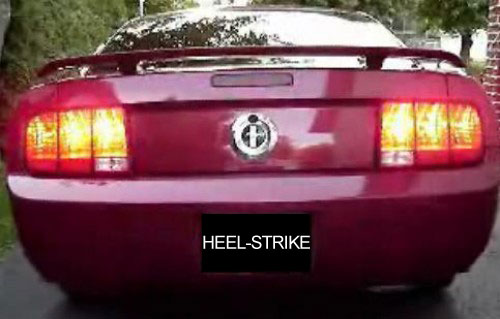by Jason Robillard.
Go to any road race. Stand at some random spot along the course. Watch as the runners pass. Count how many land with a heavy over-striding heel strike.
It’s obvious this style of running is still extremely popular. Hell, it’s even advertised for products that are supposed to be designed for midfoot striking:
Despite gobs of emerging research, diminishing support within the medical community, and even a changing paradigm within the shoe industry, over-striding with a heavy heel strike is still the preferred gait of many runners.
If everybody is doing it, is it really that bad?
Yes!
It doesn’t take a professor of kinesiology to recognize that the calcaneous, or heel bone, is not designed to absorb impact. Landing on the heel generates a tremendous amount of violent impact force which travels up the leg to the knee, hips, and back.
That part should be obvious, but most heel strikers seem content with their crappy form. After all, if it doesn’t create acute injuries today, why bother changing?
Here’s an idea that may be more persuasive:
Heel striking slows you down and limits the distance you can run.
How?
It’s simple. Driving your heel into the ground with every step creates a braking force that slows your forward momentum. Every step is reduced to a braking action with slows forward movement followed immediately by a pushing off force to re-accelerate to maintain pace. Here’s an experiment for heel strikers:
 Situation 1: Get in your car. Go to a road with no traffic. Accelerate for one mile without touching the brake. Notice it’s smooth and seamless. This is equivalent to running with good form.
Situation 1: Get in your car. Go to a road with no traffic. Accelerate for one mile without touching the brake. Notice it’s smooth and seamless. This is equivalent to running with good form.
Situation 2: Now do the same thing, except this time tap your brakes about 140 times each minute as you drive the same mile. This is what you are doing when you overstride with a heel strike.
How did that work out for you? Notice a significant difference?
If you have a fancy car that measures average miles per gallon (or kilometers per liter for the rest of the world), try the experiment again and reset the MPG counter each time.
You get significantly better gas mileage when you don’t hit the brakes, right? It’s far more efficient, allows you to drive faster, and ultimately allows you to drive longer, right? Hitting the brakes requires far more energy to cover the same distance.
Great! Now apply the same lesson to running.
This essay originally appeared on Barefoot Running University.

Good. Simple. To the point.
I love this article.
One of my new runners (I am a coach) went to a local store the other day and was told that she needed a ‘traditional’ shoe because she is a heel striker. She said she is working on getting off her heel, the first thing I look at regarding coaching. They told her that you are born that way. She bought a zero drop shoe, anyway. When I first watched her run in the new shoe, the difference was amazing from the first step. She is doing well in them, and from the very first step discovered that her knee pain disappeared. I am disappointed that most specialty shoe stores seem to push all runners to traditional shoes, especially newer runners.